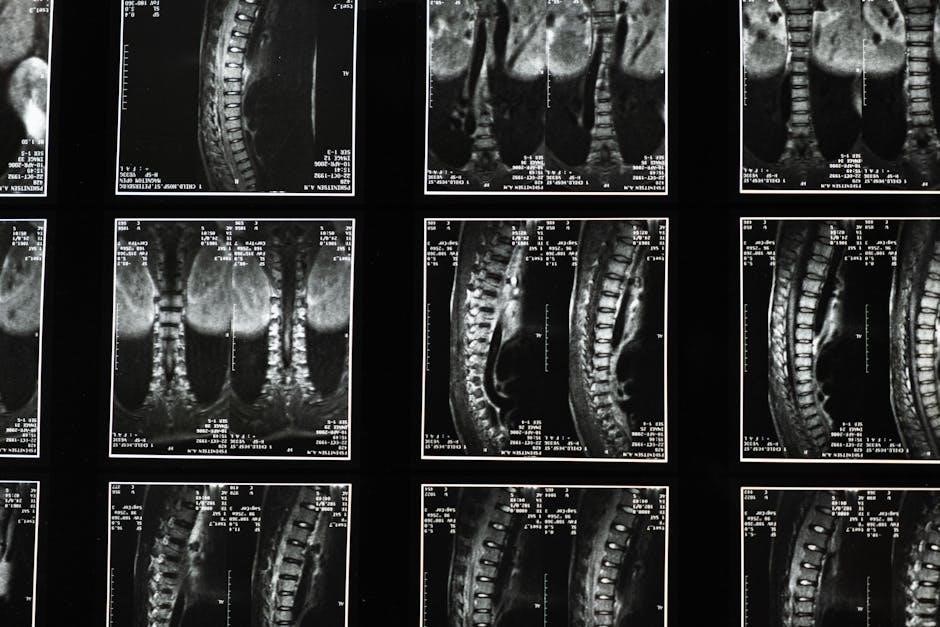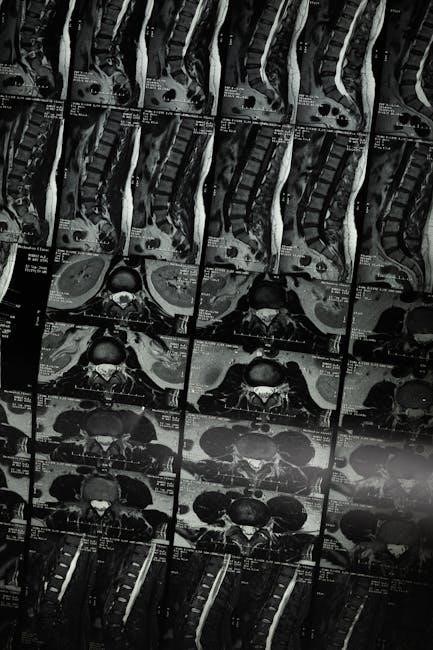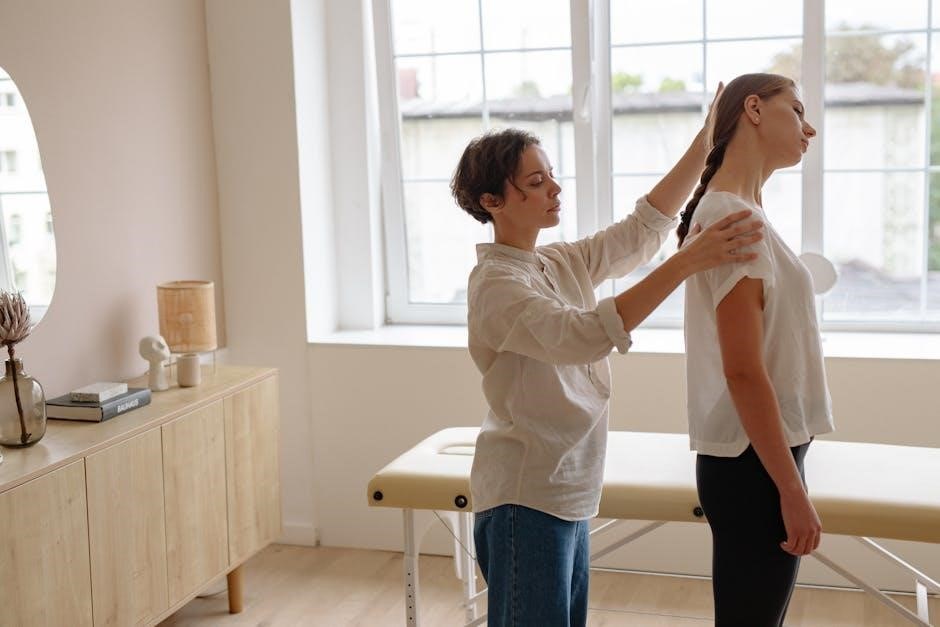
lumbar spinal stenosis exercises pdf
Lumbar spinal stenosis exercises are essential for managing symptoms and improving mobility; Gentle stretches, core strengthening, and flexibility routines can alleviate pain and enhance quality of life. A downloadable PDF guide provides structured workouts tailored to LSS, ensuring safe and effective practice at home.
- Relieves pain and stiffness
- Improves spinal flexibility
- Strengthens core muscles
- Enhances overall well-being
1.1 Overview of Lumbar Spinal Stenosis (LSS)
Lumbar spinal stenosis (LSS) is a condition where the spinal canal in the lower back narrows, compressing nerves and causing pain, numbness, or weakness. It often affects adults over 50 due to aging or degenerative changes. Symptoms include back pain, leg discomfort, and limited mobility. While treatments vary, exercises play a crucial role in managing symptoms, improving flexibility, and strengthening muscles. A lumbar spinal stenosis exercises PDF offers a structured approach to safe and effective workouts tailored to LSS.
- Common in older adults
- Causes pain and limited mobility
- Exercise is a key management strategy
1.2 Importance of Exercise in Managing LSS
Exercise is a cornerstone in managing lumbar spinal stenosis, offering numerous benefits. It helps alleviate pain, enhances spinal mobility, and strengthens core muscles, improving overall stability. Regular physical activity can delay symptom progression and reduce the need for surgical intervention. A structured lumbar spinal stenosis exercises PDF provides clear, safe routines tailored to individual needs, promoting long-term relief and better quality of life for those with LSS.
- Reduces pain and discomfort
- Enhances mobility and flexibility
- Strengthens supportive muscles
- Supports long-term symptom management

Understanding Lumbar Spinal Stenosis
Lumbar spinal stenosis is a progressive condition where the spinal canal in the lower back narrows, compressing nerves and causing pain, numbness, or weakness in the legs and buttocks.
2.1 What is Lumbar Spinal Stenosis?
Lumbar spinal stenosis (LSS) is a condition where the spinal canal in the lower back narrows, compressing nerves and causing pain, numbness, or weakness in the legs and buttocks. It often results from degenerative changes, such as osteoarthritis or disc degeneration, and is more common in adults over 50. Symptoms may include neurogenic claudication, which worsens with walking or standing. While it can progress slowly, exercises and therapies can help manage symptoms and improve mobility. Early diagnosis is crucial for effective treatment.
2.2 Types of Lumbar Spinal Stenosis
Lumbar spinal stenosis can be classified into three main types: central, foraminal, and lateral recess stenosis. Central stenosis involves narrowing of the central spinal canal, often compressing the spinal cord. Foraminal stenosis occurs when the openings through which nerve roots exit the spine become narrowed. Lateral recess stenosis affects the narrow spaces on either side of the spinal canal. Each type may cause distinct symptoms, such as leg pain, numbness, or weakness, and requires tailored treatment approaches.
- Central stenosis: Narrowing of the spinal canal
- Foraminal stenosis: Compression of nerve roots
- Lateral recess stenosis: Narrowing of side spaces
2.3 Causes and Risk Factors
Lumbar spinal stenosis is often caused by degenerative changes, such as osteoarthritis, disc degeneration, and thickened ligaments. Aging is a primary risk factor, as spinal wear and tear accumulates over time. Obesity, a sedentary lifestyle, and genetic predisposition can also contribute. Conditions like spondylolisthesis or spinal fractures may exacerbate narrowing. Smoking and poor posture further increase the likelihood of developing LSS. These factors can lead to nerve compression, worsening symptoms, and reduced mobility.
- Aging and degenerative changes
- Obesity and lack of physical activity
- Genetic predisposition
- Pre-existing spinal conditions
2.4 Common Symptoms and Diagnosis
Lumbar spinal stenosis often presents with lower back pain, numbness, or tingling in the legs and feet. Neurogenic claudication, characterized by pain during walking, is common. Symptoms worsen with standing or activity and may improve with sitting or bending forward. Diagnosis involves MRI or CT scans to confirm spinal narrowing, along with physical exams to assess nerve function and mobility. Early identification is crucial for effective management and treatment planning.
- Lower back pain or stiffness
- Numbness or tingling in legs
- Neurogenic claudication
- Relief when bending forward

Benefits of Exercises for Lumbar Spinal Stenosis
Exercises for lumbar spinal stenosis reduce pain, improve mobility, and strengthen core muscles. They can delay surgery and enhance overall quality of life by addressing symptoms effectively.
- Relieves pain and discomfort
- Improves spinal flexibility
- Strengthens lower back muscles
- Delays or avoids surgery
3.1 Relief from Pain and Discomfort
Exercises for lumbar spinal stenosis can significantly reduce pain and discomfort by improving spinal alignment and relieving pressure on nerves. Gentle stretches and strengthening routines help alleviate stiffness, while core exercises enhance stability. Regular practice can minimize symptoms like numbness and tingling, improving overall comfort and mobility. A structured PDF guide ensures exercises are performed safely and effectively, offering long-term relief and improving quality of life.
- Reduces nerve compression
- Eases stiffness and numbness
- Improves posture and alignment
- Enhances comfort during daily activities
3.2 Improving Spinal Mobility and Flexibility
Exercises for lumbar spinal stenosis focus on enhancing spinal mobility and flexibility to reduce stiffness and improve range of motion. Gentle stretches, such as pelvic tilts and seated lumbar flexion, help maintain spinal alignment and reduce tension. Regular practice can improve posture, making daily activities easier. A comprehensive PDF guide offers structured routines to safely increase flexibility and mobility, ensuring long-term spinal health and comfort.
- Enhances range of motion
- Reduces stiffness and tension
- Improves posture and alignment
- Supports daily activity performance
3;3 Strengthening Core and Lower Back Muscles
Strengthening the core and lower back muscles is crucial for stabilizing the spine and reducing pressure on nerves affected by lumbar spinal stenosis. Exercises like bird-dog, bridge, and pelvic tilts target these areas, enhancing spinal stability. A PDF guide provides detailed routines to safely build strength, improving posture and reducing discomfort. Regular practice helps prevent muscle atrophy and supports overall spinal health.
- Enhances spinal stability
- Reduces nerve pressure
- Improves posture and strength
- Prevents muscle atrophy
3.4 Delaying or Avoiding Surgical Intervention
Consistent exercise for lumbar spinal stenosis can help delay or avoid surgery by managing symptoms and improving spinal function. Strengthening core muscles and enhancing flexibility reduce nerve pressure and alleviate pain. A structured PDF guide offers tailored routines to promote long-term spinal health. While exercises can’t reverse stenosis, they often reduce its impact, allowing many patients to avoid invasive procedures and maintain an active lifestyle.
- Reduces need for surgery
- Manages symptoms effectively
- Improves long-term spinal health
- Supports an active lifestyle

Types of Exercises for Lumbar Spinal Stenosis
Lumbar spinal stenosis exercises include stretching, strengthening, flexibility, and aerobic routines. These workouts target core muscles, improve mobility, and reduce discomfort. A PDF guide offers structured plans.
- Stretching for flexibility
- Strengthening core muscles
- Improving spinal mobility
- Aerobic exercises for overall health

4.1 Stretching Exercises
Stretching exercises are crucial for improving flexibility and relieving stiffness in lumbar spinal stenosis. Gentle movements like seated lumbar flexion stretches and pelvic tilts can help reduce discomfort. These exercises target tight muscles, enhancing spinal mobility and posture. A PDF guide often includes detailed illustrations and instructions for proper form. Regular stretching can improve daily activities and reduce pain. Examples include:
- Seated Lumbar Flexion Stretch
- Knee-to-Chest Stretch
- Hamstring and Hip Flexor Stretches
These stretches promote relaxation and reduce nerve compression, aiding in symptom management.
4.2 Strengthening Exercises
Strengthening exercises are vital for stabilizing the lumbar spine and improving posture in individuals with spinal stenosis. These exercises target core muscles, including abdominals and back muscles, to provide better spinal support. Gentle routines like pelvic tilts, bridges, and planks are effective. Strengthening the glutes and hamstrings also helps reduce strain on the lower back. A lumbar spinal stenosis exercises PDF often includes step-by-step guidance for these workouts. Regular practice can enhance spinal stability and reduce pain, promoting long-term management of LSS symptoms.
- Pelvic tilts
- Bridging exercises
- Plank variations
- Bird-Dog exercises
4.3 Flexibility and Mobility Exercises
lumbar spinal stenosis exercises PDF often includes detailed illustrations and instructions for these routines. Regular practice enhances flexibility, making daily activities easier and more comfortable for those with LSS.
- Seated lumbar flexion stretches
- Cat-cow spinal movements
- Knee-to-chest stretches
- Hip flexor stretches
4.4 Aerobic Exercises
Aerobic exercises, such as walking, swimming, and cycling, are excellent for improving cardiovascular health and reducing symptoms of lumbar spinal stenosis. These low-impact activities promote blood flow, strengthen muscles, and enhance mobility without putting excessive strain on the spine. Regular aerobic exercise can also help with weight management, reducing pressure on the lower back. A lumbar spinal stenosis exercises PDF often includes aerobic routines tailored to improve overall fitness while minimizing discomfort.
- Walking
- Swimming
- Cycling
- Low-impact aerobics

4.5 Core Stability Exercises
Core stability exercises are crucial for improving balance, posture, and spinal support in individuals with lumbar spinal stenosis. These exercises target the abdominal and back muscles, enhancing the spine’s stability and reducing strain. Examples include pelvic tilts, planks, and bridges. Strengthening the core helps alleviate pain and improves mobility. A lumbar spinal stenosis exercises PDF often highlights these routines, ensuring they are performed safely and effectively to promote long-term spinal health.
- Pelvic tilts
- Planks
- Bridges
- Bird-dog exercises

Creating a Safe and Effective Exercise Routine
Consult a healthcare provider to tailor exercises to your needs. Start slowly, progress gradually, and monitor improvements. Avoid overexertion to ensure safety and long-term benefits.
5.1 Starting Slowly and Progressing Gradually
Begin with gentle exercises like pelvic tilts or knee rolls to avoid overexertion. Gradually increase intensity and duration as strength and flexibility improve. Rest days are crucial for recovery. Monitor progress and adjust routines to ensure safety and effectiveness. Focus on controlled movements and proper form to prevent discomfort. Incorporate exercises like seated stretches or lumbar flexion to improve mobility. Avoid pushing through pain; stop and consult a healthcare provider if symptoms worsen. Consistency and patience are key to achieving long-term benefits and managing LSS effectively.
5.2 Sample Exercise Routine for LSS
A sample routine for LSS includes pelvic tilts, knee rolls, and seated stretches. Start with 5-10 pelvic tilts to warm up the lower back. Follow with 10 knee rolls to improve spinal mobility. Perform seated lumbar flexion stretches, bending forward gently. Include 10 bird-dog exercises to strengthen the core. Finish with 5-10 minutes of brisk walking. Repeat this routine 2-3 times daily. Hold stretches for 20-30 seconds and rest between sets. Consult a healthcare provider to tailor the routine to your needs.
5.3 Incorporating Exercises into Daily Life
Incorporating LSS exercises into daily life can be simple and effective. Start with gentle stretches during work breaks or while watching TV. Perform pelvis tilts or seated lumbar flexions in the morning to improve mobility. Short walks after meals can enhance circulation and reduce stiffness. Use a Lumbar Spinal Stenosis Exercise PDF as a quick reference for routines. Make exercises a habit by scheduling them into your daily planner. Consistency is key to managing symptoms and improving overall well-being.
- Stretch during work breaks
- Walk after meals
- Use a PDF guide for quick reference
- Schedule exercises into your daily routine
5.4 Monitoring Progress and Adjustments
Monitoring progress and making adjustments is crucial for effective LSS exercise routines. Track improvements in pain levels, walking distance, and flexibility. Use a journal to log exercises performed and any discomfort experienced. Adjust intensity or duration based on progress, ensuring exercises remain challenging yet manageable. Regularly review your Lumbar Spinal Stenosis Exercise PDF to stay on track. Consult a healthcare provider to refine your program and address any plateaus or concerns, ensuring long-term success and symptom relief.
- Track pain levels and walking distance
- Log exercises and discomfort
- Adjust intensity or duration as needed
- Consult a healthcare provider for refinements

Safety Precautions and Considerations
Always consult a healthcare provider before starting exercises for lumbar spinal stenosis. Listen to your body and stop if pain occurs. Modify exercises to suit your condition and avoid overexertion. Use a reliable Lumbar Spinal Stenosis Exercise PDF for guidance to ensure safety and effectiveness.
- Consult a healthcare provider first
- Stop if pain or discomfort arises
- Modify exercises as needed
6.1 Understanding Your Limits and Avoiding Overexertion
Understanding your physical limits is crucial when performing exercises for lumbar spinal stenosis. Overexertion can worsen symptoms, so it’s important to pace yourself and avoid pushing too hard. Start with gentle movements and gradually increase intensity as comfort allows. Pain is a sign to stop or modify the exercise. A Lumbar Spinal Stenosis Exercise PDF can help guide you in setting realistic goals and avoiding excessive strain, ensuring a safe and effective routine.
- Listen to your body and stop if pain occurs
- Begin with gentle exercises and progress slowly
- Avoid activities that cause discomfort or strain
6.2 When to Stop or Modify Exercises
If you experience increased pain, numbness, tingling, or dizziness during or after exercises, stop immediately. Severe or worsening symptoms, such as radiating leg pain or difficulty walking, also warrant stopping. If exercises cause discomfort or fatigue, modify them to a more comfortable level. Consulting a healthcare provider is essential before resuming. A Lumbar Spinal Stenosis Exercise PDF guide can offer tips on safely adjusting routines to suit individual needs and avoid aggravating the condition.
- Stop if pain or numbness increases
- Modify exercises to avoid discomfort
- Consult a healthcare provider before continuing
6.3 Importance of Consultation with a Healthcare Provider
Consulting a healthcare provider is crucial before starting any exercise program for lumbar spinal stenosis. They ensure exercises are tailored to your condition, avoiding overexertion or further injury. A provider can assess your specific needs, monitor progress, and adjust routines as necessary. Without professional guidance, exercises may worsen symptoms or lead to complications. A healthcare provider can also recommend a suitable PDF guide for safe and effective practice, ensuring exercises align with your treatment plan and promote long-term relief.
- Ensures exercises are safe and appropriate
- Helps avoid worsening symptoms
- Provides personalized guidance

Lumbar Spinal Stenosis Exercise PDF Guide
A comprehensive PDF guide offers detailed exercises, stretches, and core-strengthening routines for lumbar spinal stenosis relief. It’s free, printable, and essential for managing symptoms effectively at home.
7.1 Benefits of a Printable Exercise Guide
A printable exercise guide for lumbar spinal stenosis offers convenience and accessibility. It provides clear, structured routines that can be followed at home, helping to manage symptoms effectively. The guide often includes illustrations, step-by-step instructions, and progress tracking, making it easier to stay consistent. Having a physical copy ensures exercises are always available, promoting adherence to a regular routine. This resource is particularly useful for those seeking to improve mobility, reduce pain, and strengthen core muscles without relying on digital devices.
- Convenient and portable
- Easy-to-follow instructions
- Enhances consistency
- Supports long-term progress
7.2 What to Include in Your Exercise PDF
Your exercise PDF should include clear instructions, images, and safety tips. List exercises like pelvic tilts, knee-to-chest stretches, and cat-cow movements. Add warm-up routines and cool-down stretches. Include guidance on modifying exercises for individual needs and tracking progress. Emphasize the importance of consulting a healthcare provider before starting. Ensure the guide is easy to follow with visuals and step-by-step descriptions.
- Warm-up and cool-down routines
- Illustrations of each exercise
- Safety precautions and tips
- Progress tracking and notes section
7.3 Finding Reliable Sources for Exercise Guides
Reliable sources for exercise guides include reputable medical websites, orthopedic associations, and physical therapy resources. Look for guides endorsed by healthcare professionals or organizations like the North American Spine Society. Peer-reviewed journals and official health websites are also trustworthy. Ensure the content is evidence-based and tailored to lumbar spinal stenosis. Avoid unverified sources and always consult a healthcare provider before starting any program.
- Reputable medical websites
- Orthopedic and spine associations
- Physical therapy resources
- Peer-reviewed journals

Success Stories and Case Studies
Real-life examples highlight how consistent exercise routines alleviate symptoms and improve mobility in lumbar spinal stenosis patients, often delaying or avoiding surgery.
- Pain relief and improved mobility
- Delayed surgical intervention
- Enhanced quality of life
8.1 Real-Life Examples of Exercise Benefits
Patient testimonials reveal significant improvements in mobility and pain reduction through targeted exercises. For instance, many individuals with LSS report enhanced walking distances and reduced discomfort after incorporating core strengthening and flexibility routines. Downloadable PDF guides often feature success stories, showcasing how exercises like pelvic tilts and seated stretches provided lasting relief. These examples emphasize the importance of consistency and proper technique in managing symptoms effectively. Real-life outcomes inspire others to adopt exercise as a key component of their treatment plan.
- Improved walking ability
- Reduced pain levels
- Enhanced daily functioning
- Delayed need for surgery
8.2 Patient Testimonials and Outcomes
Many patients with lumbar spinal stenosis have shared positive experiences with exercise programs. They report reduced pain, improved mobility, and better ability to perform daily activities without discomfort. Testimonials highlight how exercises like pelvic tilts and stretches, often found in downloadable PDF guides, have significantly enhanced their quality of life. These real-life success stories not only demonstrate the effectiveness of exercise in managing symptoms but also inspire others to adopt these routines, showing tangible improvements in overall well-being and daily functioning.
- Reduced pain and discomfort
- Improved mobility and flexibility
- Enhanced ability to perform daily tasks
- Overall improvement in quality of life
8.3 Motivational Tips for Consistency
Consistency is key to benefiting from lumbar spinal stenosis exercises. Start with small, achievable goals and track progress to stay motivated. Celebrate each milestone, no matter how small, to reinforce commitment. Incorporate exercises into your daily routine, such as during commercial breaks while watching TV. Surround yourself with a supportive community or partner to enhance accountability. Remind yourself of the long-term benefits, like improved mobility and reduced pain, to stay driven. Using a downloadable PDF guide can also help maintain structure and organization in your exercise journey.
- Set realistic and achievable goals
- Track progress and celebrate milestones
- Incorporate exercises into daily routines
- Stay accountable with a partner or community
Lumbar spinal stenosis exercises offer effective management of symptoms, improving mobility and reducing discomfort. Regular practice, guided by a PDF, promotes long-term spinal health and well-being.
9.1 Summary of Key Points
Lumbar spinal stenosis exercises are a vital component in managing symptoms and enhancing quality of life. They focus on relieving pain, improving mobility, and strengthening core muscles. A PDF guide provides structured routines, including stretches, flexibility exercises, and aerobic activities, tailored to individual needs. Regular practice can delay surgical intervention and promote long-term spinal health. Consistency and consultation with a healthcare provider are key to maximizing benefits and ensuring safety. These exercises empower individuals to take control of their condition effectively.
9.2 Encouragement to Begin an Exercise Program
Starting an exercise program for lumbar spinal stenosis can significantly improve your quality of life. Even small, consistent efforts can lead to meaningful changes, such as reduced pain and increased mobility. Gentle stretches, core-strengthening exercises, and low-impact activities are safe and effective. A downloadable PDF guide offers structured routines to help you get started. Remember, consistency is key, and progress may be gradual, but the benefits to your spinal health and overall well-being are worth the commitment.
- Reduces pain and discomfort
- Improves mobility and strength
- Enhances long-term spinal health